C464 Task 1: Presentation Plan for Cross-Cultural Communication
VerifiedAdded on 2022/10/01
|6
|1415
|31
Presentation
AI Summary
This presentation plan, designed for WGU's C464 Introduction to Communication course, focuses on the critical importance of cross-cultural communication in today's diverse workplaces. The plan outlines an introduction that grabs the audience's attention by highlighting the prevalence of diversity in modern workplaces, followed by a thesis statement emphasizing the need for managers and supervisors to engage in cross-cultural communication to address potential disputes. The body of the presentation elaborates on the globalization of cultures, the evolution of workplaces, and the complications arising from conflicting opinions. It also stresses the importance of cultural awareness and the role of leadership in fostering mutual respect and understanding. The plan concludes by restating the thesis and summarizing the main points, emphasizing the need for embracing diversity and promoting tolerance within organizations. The presentation plan includes a detailed reference list in APA format, citing relevant sources on cross-cultural communication, leadership, and diversity in the workplace. This plan serves as a valuable resource for students seeking to understand and address the complexities of cross-cultural communication in professional settings.
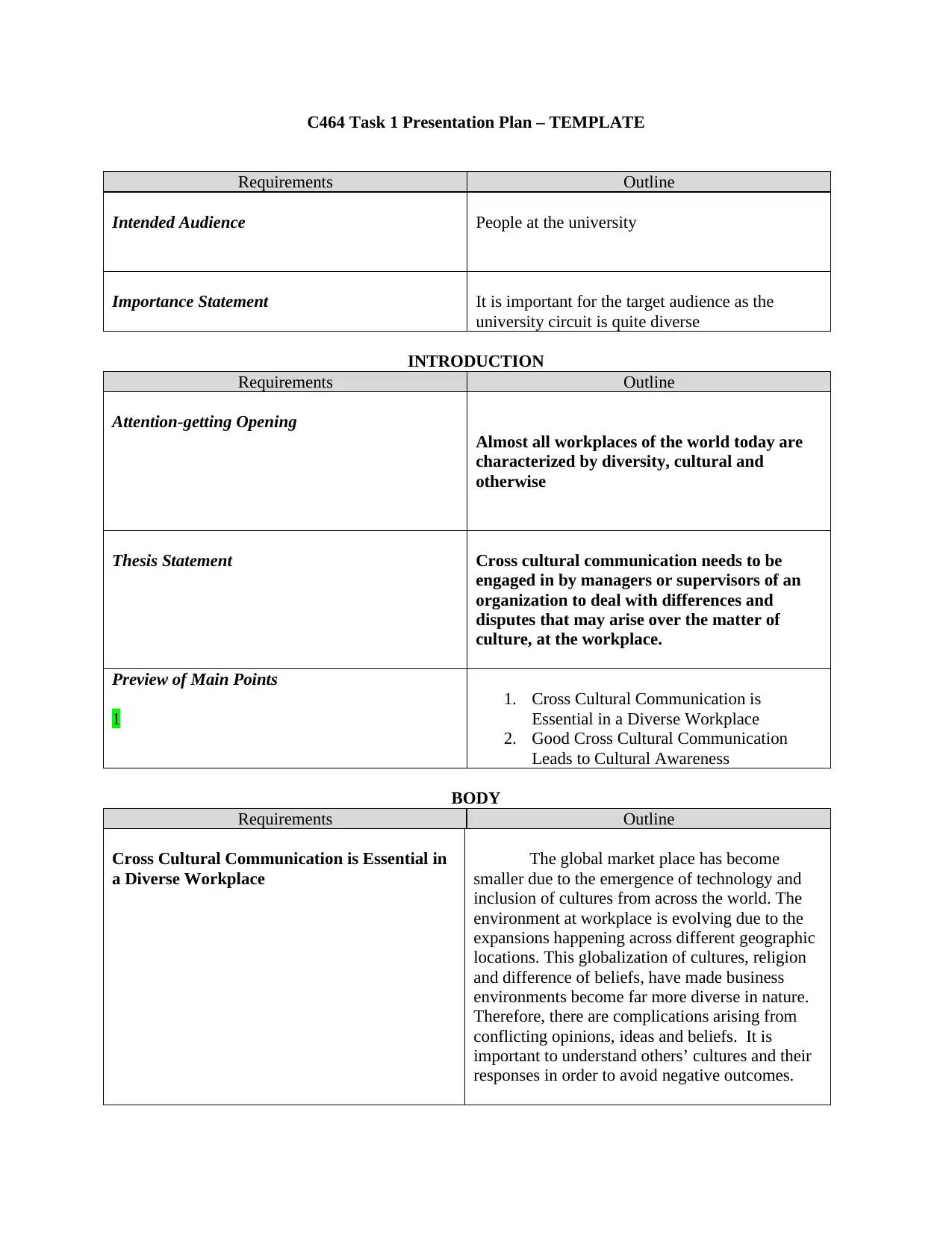
C464 Task 1 Presentation Plan – TEMPLATE
Requirements Outline
Intended Audience People at the university
Importance Statement It is important for the target audience as the
university circuit is quite diverse
INTRODUCTION
Requirements Outline
Attention-getting Opening
Almost all workplaces of the world today are
characterized by diversity, cultural and
otherwise
Thesis Statement Cross cultural communication needs to be
engaged in by managers or supervisors of an
organization to deal with differences and
disputes that may arise over the matter of
culture, at the workplace.
Preview of Main Points
1
1. Cross Cultural Communication is
Essential in a Diverse Workplace
2. Good Cross Cultural Communication
Leads to Cultural Awareness
BODY
Requirements Outline
Cross Cultural Communication is Essential in
a Diverse Workplace
The global market place has become
smaller due to the emergence of technology and
inclusion of cultures from across the world. The
environment at workplace is evolving due to the
expansions happening across different geographic
locations. This globalization of cultures, religion
and difference of beliefs, have made business
environments become far more diverse in nature.
Therefore, there are complications arising from
conflicting opinions, ideas and beliefs. It is
important to understand others’ cultures and their
responses in order to avoid negative outcomes.
Requirements Outline
Intended Audience People at the university
Importance Statement It is important for the target audience as the
university circuit is quite diverse
INTRODUCTION
Requirements Outline
Attention-getting Opening
Almost all workplaces of the world today are
characterized by diversity, cultural and
otherwise
Thesis Statement Cross cultural communication needs to be
engaged in by managers or supervisors of an
organization to deal with differences and
disputes that may arise over the matter of
culture, at the workplace.
Preview of Main Points
1
1. Cross Cultural Communication is
Essential in a Diverse Workplace
2. Good Cross Cultural Communication
Leads to Cultural Awareness
BODY
Requirements Outline
Cross Cultural Communication is Essential in
a Diverse Workplace
The global market place has become
smaller due to the emergence of technology and
inclusion of cultures from across the world. The
environment at workplace is evolving due to the
expansions happening across different geographic
locations. This globalization of cultures, religion
and difference of beliefs, have made business
environments become far more diverse in nature.
Therefore, there are complications arising from
conflicting opinions, ideas and beliefs. It is
important to understand others’ cultures and their
responses in order to avoid negative outcomes.
Paraphrase This Document
Need a fresh take? Get an instant paraphrase of this document with our AI Paraphraser
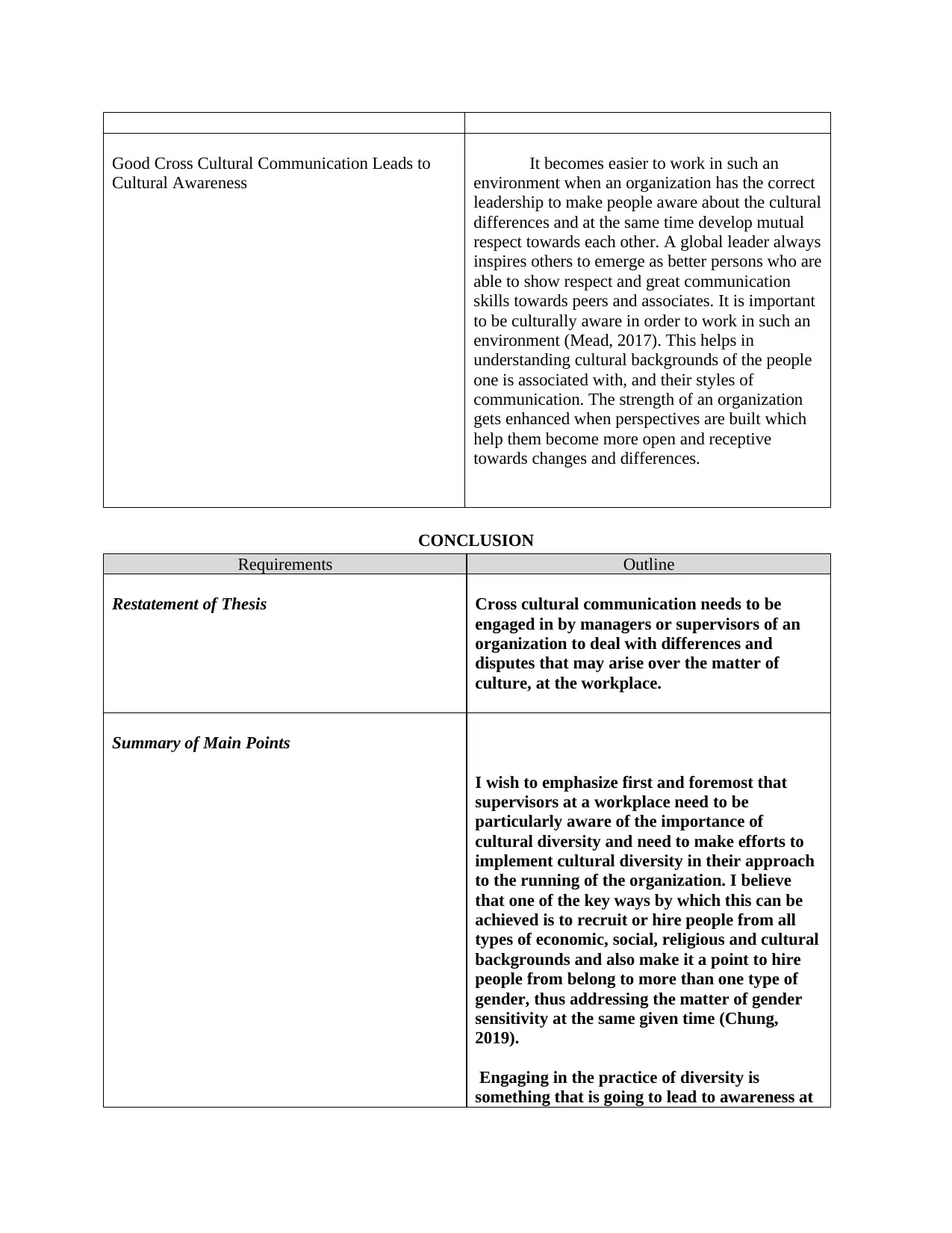
Good Cross Cultural Communication Leads to
Cultural Awareness
It becomes easier to work in such an
environment when an organization has the correct
leadership to make people aware about the cultural
differences and at the same time develop mutual
respect towards each other. A global leader always
inspires others to emerge as better persons who are
able to show respect and great communication
skills towards peers and associates. It is important
to be culturally aware in order to work in such an
environment (Mead, 2017). This helps in
understanding cultural backgrounds of the people
one is associated with, and their styles of
communication. The strength of an organization
gets enhanced when perspectives are built which
help them become more open and receptive
towards changes and differences.
CONCLUSION
Requirements Outline
Restatement of Thesis Cross cultural communication needs to be
engaged in by managers or supervisors of an
organization to deal with differences and
disputes that may arise over the matter of
culture, at the workplace.
Summary of Main Points
I wish to emphasize first and foremost that
supervisors at a workplace need to be
particularly aware of the importance of
cultural diversity and need to make efforts to
implement cultural diversity in their approach
to the running of the organization. I believe
that one of the key ways by which this can be
achieved is to recruit or hire people from all
types of economic, social, religious and cultural
backgrounds and also make it a point to hire
people from belong to more than one type of
gender, thus addressing the matter of gender
sensitivity at the same given time (Chung,
2019).
Engaging in the practice of diversity is
something that is going to lead to awareness at
Cultural Awareness
It becomes easier to work in such an
environment when an organization has the correct
leadership to make people aware about the cultural
differences and at the same time develop mutual
respect towards each other. A global leader always
inspires others to emerge as better persons who are
able to show respect and great communication
skills towards peers and associates. It is important
to be culturally aware in order to work in such an
environment (Mead, 2017). This helps in
understanding cultural backgrounds of the people
one is associated with, and their styles of
communication. The strength of an organization
gets enhanced when perspectives are built which
help them become more open and receptive
towards changes and differences.
CONCLUSION
Requirements Outline
Restatement of Thesis Cross cultural communication needs to be
engaged in by managers or supervisors of an
organization to deal with differences and
disputes that may arise over the matter of
culture, at the workplace.
Summary of Main Points
I wish to emphasize first and foremost that
supervisors at a workplace need to be
particularly aware of the importance of
cultural diversity and need to make efforts to
implement cultural diversity in their approach
to the running of the organization. I believe
that one of the key ways by which this can be
achieved is to recruit or hire people from all
types of economic, social, religious and cultural
backgrounds and also make it a point to hire
people from belong to more than one type of
gender, thus addressing the matter of gender
sensitivity at the same given time (Chung,
2019).
Engaging in the practice of diversity is
something that is going to lead to awareness at
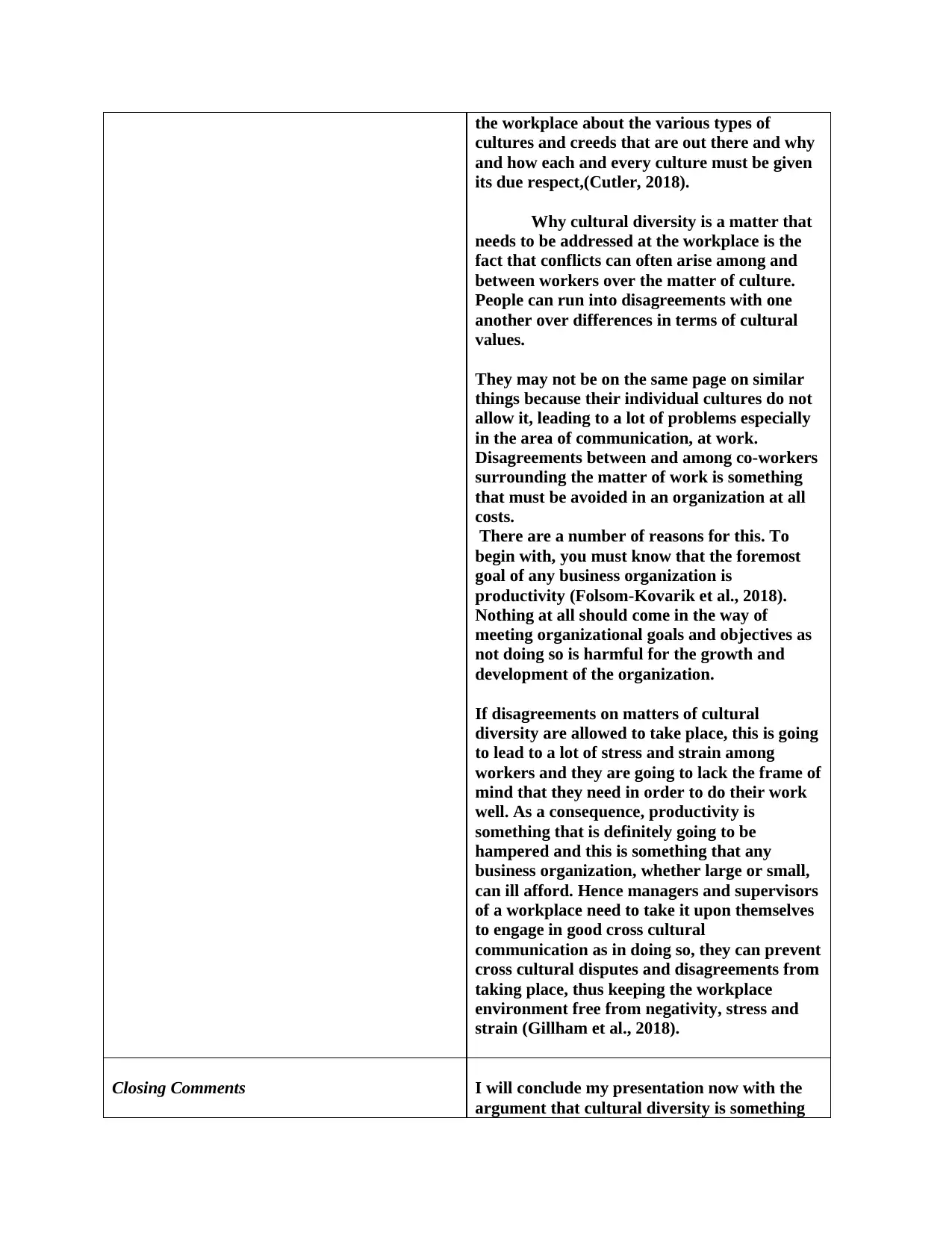
the workplace about the various types of
cultures and creeds that are out there and why
and how each and every culture must be given
its due respect,(Cutler, 2018).
Why cultural diversity is a matter that
needs to be addressed at the workplace is the
fact that conflicts can often arise among and
between workers over the matter of culture.
People can run into disagreements with one
another over differences in terms of cultural
values.
They may not be on the same page on similar
things because their individual cultures do not
allow it, leading to a lot of problems especially
in the area of communication, at work.
Disagreements between and among co-workers
surrounding the matter of work is something
that must be avoided in an organization at all
costs.
There are a number of reasons for this. To
begin with, you must know that the foremost
goal of any business organization is
productivity (Folsom-Kovarik et al., 2018).
Nothing at all should come in the way of
meeting organizational goals and objectives as
not doing so is harmful for the growth and
development of the organization.
If disagreements on matters of cultural
diversity are allowed to take place, this is going
to lead to a lot of stress and strain among
workers and they are going to lack the frame of
mind that they need in order to do their work
well. As a consequence, productivity is
something that is definitely going to be
hampered and this is something that any
business organization, whether large or small,
can ill afford. Hence managers and supervisors
of a workplace need to take it upon themselves
to engage in good cross cultural
communication as in doing so, they can prevent
cross cultural disputes and disagreements from
taking place, thus keeping the workplace
environment free from negativity, stress and
strain (Gillham et al., 2018).
Closing Comments I will conclude my presentation now with the
argument that cultural diversity is something
cultures and creeds that are out there and why
and how each and every culture must be given
its due respect,(Cutler, 2018).
Why cultural diversity is a matter that
needs to be addressed at the workplace is the
fact that conflicts can often arise among and
between workers over the matter of culture.
People can run into disagreements with one
another over differences in terms of cultural
values.
They may not be on the same page on similar
things because their individual cultures do not
allow it, leading to a lot of problems especially
in the area of communication, at work.
Disagreements between and among co-workers
surrounding the matter of work is something
that must be avoided in an organization at all
costs.
There are a number of reasons for this. To
begin with, you must know that the foremost
goal of any business organization is
productivity (Folsom-Kovarik et al., 2018).
Nothing at all should come in the way of
meeting organizational goals and objectives as
not doing so is harmful for the growth and
development of the organization.
If disagreements on matters of cultural
diversity are allowed to take place, this is going
to lead to a lot of stress and strain among
workers and they are going to lack the frame of
mind that they need in order to do their work
well. As a consequence, productivity is
something that is definitely going to be
hampered and this is something that any
business organization, whether large or small,
can ill afford. Hence managers and supervisors
of a workplace need to take it upon themselves
to engage in good cross cultural
communication as in doing so, they can prevent
cross cultural disputes and disagreements from
taking place, thus keeping the workplace
environment free from negativity, stress and
strain (Gillham et al., 2018).
Closing Comments I will conclude my presentation now with the
argument that cultural diversity is something
⊘ This is a preview!⊘
Do you want full access?
Subscribe today to unlock all pages.

Trusted by 1+ million students worldwide
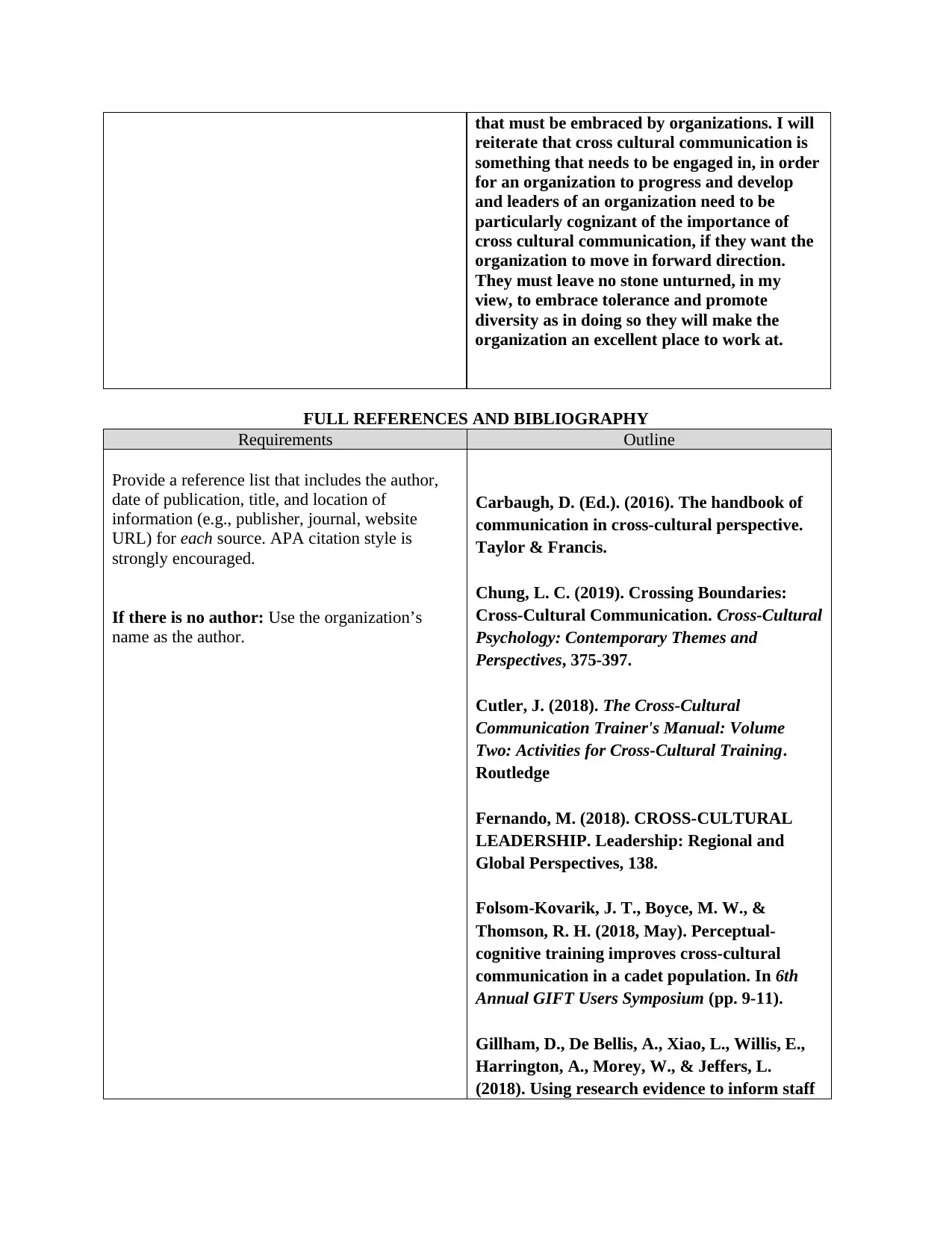
that must be embraced by organizations. I will
reiterate that cross cultural communication is
something that needs to be engaged in, in order
for an organization to progress and develop
and leaders of an organization need to be
particularly cognizant of the importance of
cross cultural communication, if they want the
organization to move in forward direction.
They must leave no stone unturned, in my
view, to embrace tolerance and promote
diversity as in doing so they will make the
organization an excellent place to work at.
FULL REFERENCES AND BIBLIOGRAPHY
Requirements Outline
Provide a reference list that includes the author,
date of publication, title, and location of
information (e.g., publisher, journal, website
URL) for each source. APA citation style is
strongly encouraged.
If there is no author: Use the organization’s
name as the author.
Carbaugh, D. (Ed.). (2016). The handbook of
communication in cross-cultural perspective.
Taylor & Francis.
Chung, L. C. (2019). Crossing Boundaries:
Cross‐Cultural Communication. Cross‐Cultural
Psychology: Contemporary Themes and
Perspectives, 375-397.
Cutler, J. (2018). The Cross-Cultural
Communication Trainer's Manual: Volume
Two: Activities for Cross-Cultural Training.
Routledge
Fernando, M. (2018). CROSS-CULTURAL
LEADERSHIP. Leadership: Regional and
Global Perspectives, 138.
Folsom-Kovarik, J. T., Boyce, M. W., &
Thomson, R. H. (2018, May). Perceptual-
cognitive training improves cross-cultural
communication in a cadet population. In 6th
Annual GIFT Users Symposium (pp. 9-11).
Gillham, D., De Bellis, A., Xiao, L., Willis, E.,
Harrington, A., Morey, W., & Jeffers, L.
(2018). Using research evidence to inform staff
reiterate that cross cultural communication is
something that needs to be engaged in, in order
for an organization to progress and develop
and leaders of an organization need to be
particularly cognizant of the importance of
cross cultural communication, if they want the
organization to move in forward direction.
They must leave no stone unturned, in my
view, to embrace tolerance and promote
diversity as in doing so they will make the
organization an excellent place to work at.
FULL REFERENCES AND BIBLIOGRAPHY
Requirements Outline
Provide a reference list that includes the author,
date of publication, title, and location of
information (e.g., publisher, journal, website
URL) for each source. APA citation style is
strongly encouraged.
If there is no author: Use the organization’s
name as the author.
Carbaugh, D. (Ed.). (2016). The handbook of
communication in cross-cultural perspective.
Taylor & Francis.
Chung, L. C. (2019). Crossing Boundaries:
Cross‐Cultural Communication. Cross‐Cultural
Psychology: Contemporary Themes and
Perspectives, 375-397.
Cutler, J. (2018). The Cross-Cultural
Communication Trainer's Manual: Volume
Two: Activities for Cross-Cultural Training.
Routledge
Fernando, M. (2018). CROSS-CULTURAL
LEADERSHIP. Leadership: Regional and
Global Perspectives, 138.
Folsom-Kovarik, J. T., Boyce, M. W., &
Thomson, R. H. (2018, May). Perceptual-
cognitive training improves cross-cultural
communication in a cadet population. In 6th
Annual GIFT Users Symposium (pp. 9-11).
Gillham, D., De Bellis, A., Xiao, L., Willis, E.,
Harrington, A., Morey, W., & Jeffers, L.
(2018). Using research evidence to inform staff
Paraphrase This Document
Need a fresh take? Get an instant paraphrase of this document with our AI Paraphraser
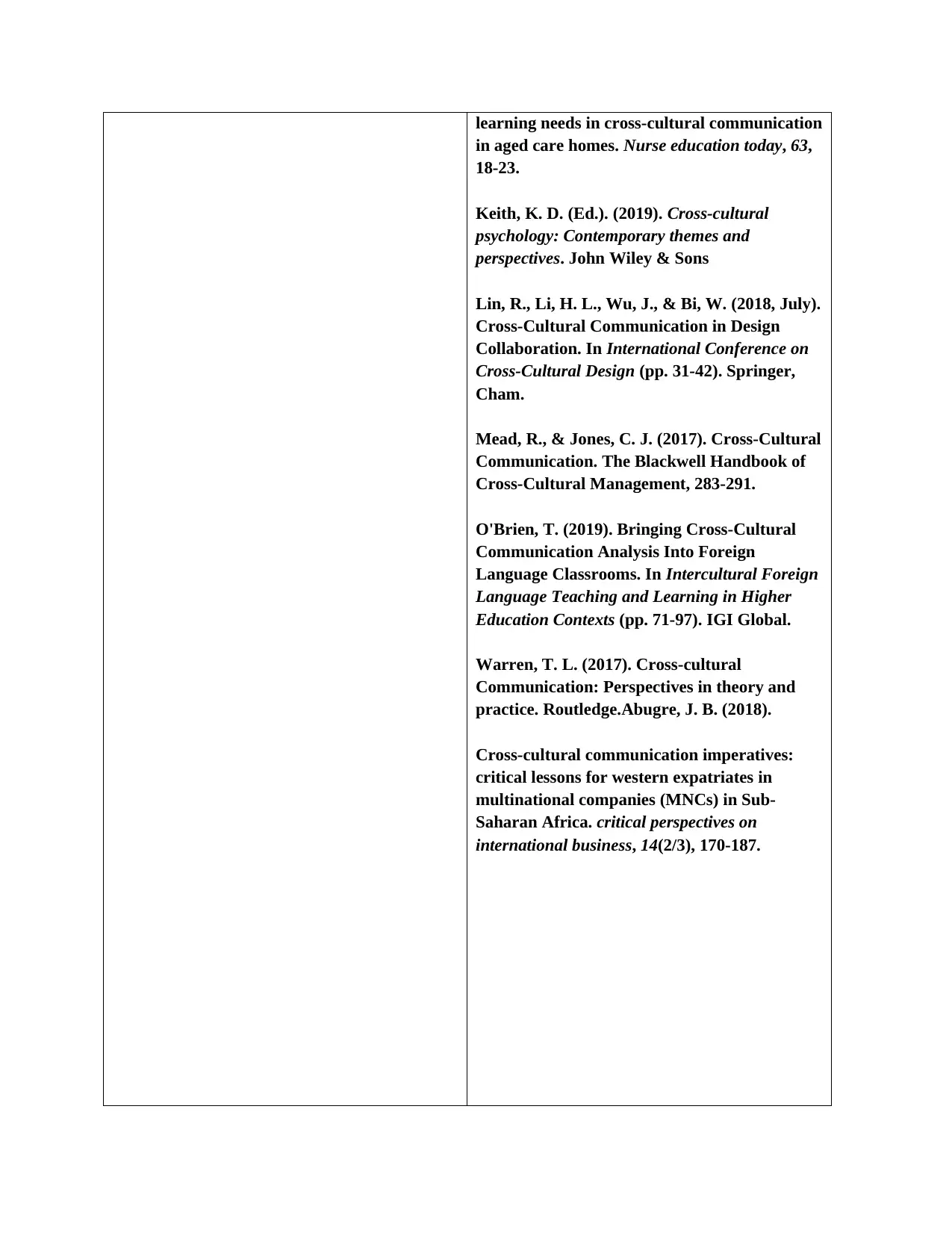
learning needs in cross-cultural communication
in aged care homes. Nurse education today, 63,
18-23.
Keith, K. D. (Ed.). (2019). Cross-cultural
psychology: Contemporary themes and
perspectives. John Wiley & Sons
Lin, R., Li, H. L., Wu, J., & Bi, W. (2018, July).
Cross-Cultural Communication in Design
Collaboration. In International Conference on
Cross-Cultural Design (pp. 31-42). Springer,
Cham.
Mead, R., & Jones, C. J. (2017). Cross‐Cultural
Communication. The Blackwell Handbook of
Cross‐Cultural Management, 283-291.
O'Brien, T. (2019). Bringing Cross-Cultural
Communication Analysis Into Foreign
Language Classrooms. In Intercultural Foreign
Language Teaching and Learning in Higher
Education Contexts (pp. 71-97). IGI Global.
Warren, T. L. (2017). Cross-cultural
Communication: Perspectives in theory and
practice. Routledge.Abugre, J. B. (2018).
Cross-cultural communication imperatives:
critical lessons for western expatriates in
multinational companies (MNCs) in Sub-
Saharan Africa. critical perspectives on
international business, 14(2/3), 170-187.
in aged care homes. Nurse education today, 63,
18-23.
Keith, K. D. (Ed.). (2019). Cross-cultural
psychology: Contemporary themes and
perspectives. John Wiley & Sons
Lin, R., Li, H. L., Wu, J., & Bi, W. (2018, July).
Cross-Cultural Communication in Design
Collaboration. In International Conference on
Cross-Cultural Design (pp. 31-42). Springer,
Cham.
Mead, R., & Jones, C. J. (2017). Cross‐Cultural
Communication. The Blackwell Handbook of
Cross‐Cultural Management, 283-291.
O'Brien, T. (2019). Bringing Cross-Cultural
Communication Analysis Into Foreign
Language Classrooms. In Intercultural Foreign
Language Teaching and Learning in Higher
Education Contexts (pp. 71-97). IGI Global.
Warren, T. L. (2017). Cross-cultural
Communication: Perspectives in theory and
practice. Routledge.Abugre, J. B. (2018).
Cross-cultural communication imperatives:
critical lessons for western expatriates in
multinational companies (MNCs) in Sub-
Saharan Africa. critical perspectives on
international business, 14(2/3), 170-187.

⊘ This is a preview!⊘
Do you want full access?
Subscribe today to unlock all pages.

Trusted by 1+ million students worldwide
1 out of 6
Related Documents
Your All-in-One AI-Powered Toolkit for Academic Success.
+13062052269
info@desklib.com
Available 24*7 on WhatsApp / Email
![[object Object]](/_next/static/media/star-bottom.7253800d.svg)
Unlock your academic potential
Copyright © 2020–2025 A2Z Services. All Rights Reserved. Developed and managed by ZUCOL.





